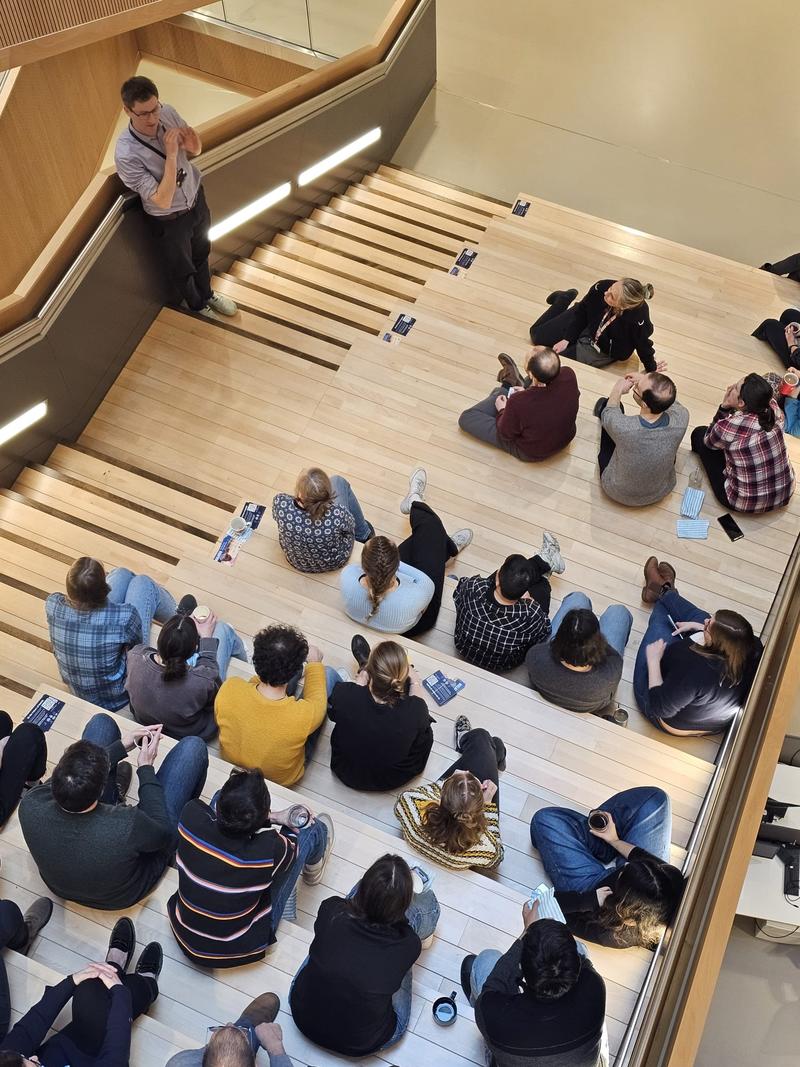On we go into 2024 and round 8 of Kavli INsD short research presentations continue
On We Go into 2024 and Round 8 of Kavli INsD Short Research Presentations Continue
To foster interdisciplinarity and understanding of each other's fields and methodologies, our researchers at Kavli INsD continued to meet up informally during February 2024 to share brief updates on their work.


Through this exchange, we aim to address significant health challenges such as antimicrobial resistance, brain and mental health, infectious diseases, and malaria. Additionally, we strive to develop innovative instrumentation that harnesses the analytical capabilities of the physical sciences to investigate cellular processes. Together, we are committed to making substantial contributions in these areas.
We are pleased to share our researcher’s presentation summaries below.
|
3-minute research presentations |
Thursday 22 February 2024 |
|
Chemistry |
Stephen Thorpe |
|
Physiology, Anatomy and Genetics |
Aishwarya Vedula |
|
Clinical Neurosciences |
Victor (Shijun) Yan |
|
Physics |
Mirjam Kümmerlin |
|
Biochemistry |
Lana Strmecki and Vojta Pražák |
|
Short Talk by Kavli Clinical Research Fellow on Oxford’s Malaria Challenge Trials |
Thursday 29 February 2024 |
|
Biochemistry |
Andrew Duncan |

Dr Stephen Thorpe
Label free imaging of proteins in suspended bilayers by mass photometry
My research focuses on how to apply micro/nanofluidics to mass photometry (MP), a label free method of measuring protein mass using light scattering. One current project is how to measure interactions with integral membrane proteins in suspended lipid bilayers using MP. We have fabricated an array of supports using a water refractive index matched polymer, which reduces the scattering of the supports themselves so that proteins can still be imaged. We have demonstrated that we can successfully form the suspended bilayer on these supports using a two phase bilayer and image the mass and diffusion of 1 MDa DNA origami which has been tethered to the bilayer by a cholesterol linker. Next we will try to insert membrane proteins into the bilayer and by continually tracking their mass over time measure affinity of their interaction with ligands coming from the solution.
#Nanofabrication #micro/nanofluidics #mass photometry #microscopy

Aishwarya Vedula, DPhil Candidate
Investigating purinergic signalling mechanisms in iPSC-derived microcircuit models of Parkinson’s disease
I am interested in the role of purines (ATP and adenosine) as neurotransmitters and the potential for modulation of purinergic signalling as disease-modifying therapies in early Parkinson’s disease. For my project, I aim to construct fluid-walled striatal microcircuits comprising iPSC-derived dopaminergic, striatal and cortical neurons, from healthy controls and patients with Parkinson’s. This is in n order to identify whether activity-dependent differences in ATP release, and ATP/adenosine modulation of dopamine release and alpha synuclein aggregation, contribute to dopamine neuron dysfunction and death, as well as downstream striatal neuron dysfunction in PD.
iPSCs #microfluidic cultures #purinergic signalling #activity-dependent mechanisms of neurodegeneration

Victor (Shijun) Yan, DPhil Candidate
Neuronally Derived Extracellular Vesicle α-Synuclein as a Serum Biomarker for Individuals at Risk of Developing Parkinson Disease
Parkinson’s disease (PD) is the second commonest neurodegenerative disease. A number of non-motor symptoms can manifest during the prodromal stage and predate the motor symptoms by decades. These symptoms broadly correlate with the evolution of α-synuclein pathology. Currently, there is no blood test to identify at-risk individuals during the prodromal phase.
My research focuses on developing improved biochemical assays and discovering novel biomarkers from extracellular vesicles in circulations to predict Parkinson’s disease risk and differentiate this disease from Parkinson's-like conditions.
In a recent paper, we demonstrated that L1CAM-positive EV α-synuclein as a proxy biomarker for identifying individuals at-risk of developing neuronal α-synucleinopathy. This biomarker offers patient-based measurements that support the existence of a fundamental shift in α-synuclein homeostasis that is detectable in blood at the early stages of the pathogenic cascade.
#Parkinson’s Disease #extracellular vesicle #α-Synuclein

Mirjam Kümmerlin, DPhil Candidate
Fluorogenic ssDNA labels for simple, specific and tuneable probing of biological processes in vitro and in vivo
Observation of biological processes using fluorescence microscopy relies on specifically labelling the target of interest – a laboursome and still limiting process. Using ssDNA carrying organic dyes allows to specifically target a molecule of interest (which carries the complementary strand) inside and outside of cells. In my work, I focus on pushing the limits of this idea by developing fluorogenic labels which only light up once bound to the target. This makes the signal more specific and greatly reduces the noise in our observations – allowing us to e.g. operate at concentrations otherwise beyond reach. We can use this to facilitate a constant exchange of labels on a molecule of interest – rendering the signal virtually inert to photobleaching (see my publication https://doi.org/10.1002/cphc.202300175). Right now, we are exploring different areas of use – ranging from single-molecule detection and in vivo observation of cellular machinery to super-resolution imaging.
#Single-molecule #Fluorescence #Super-resolution #Fluorogenicity

Dr Lana Strmecki and Dr Vojta Pražák
Laboratory efficiency practises for sustainability
In their talk Lana and Vojta shared information on how to reduce waste, save energy, and save research money by switching to reusable alternatives of laboratory consumables, available through the Media and Glass Sterilisation Laboratory embedded within the building, and by reusing essential plasticware.
Researchers form 0.1% of the population but generate ~ 2% of global plastic waste, in effect significantly contributing to the current environmental crisis1,2,3. The conservative, evidence-based culture of the scientific community means that change often happens slowly.
Green DCHB works towards improving the sustainability of research at the Kavli INsD and the Department of Biochemistry both housed in the Dorothy Crowfoot Hodgkin Building. As a part of Green Action Week in February 2024, Green DCHB held an event to share low impact research practices and promote ongoing building-wide sustainability actions.
One recent success is the new polystyrene box recycling scheme. This effort spearheaded mainly by Dr Lana Strmecki, Dr Vicki Cullen and Dr Louise Pankhurst means that polystyrene boxes are recycled and also represents a cost saving for DCHB as general waste volume is reduced.
In an effort to reduce energy consumption, Green DCHB are running a “-70 is the new -80” campaign. There is now an overwhelming volume of evidence showing that there is no benefit to sample longevity at -80° and that the 10°C difference represents a 30% increase in energy consumption4. If all labs switched their ultra-low temperature freezers to -70, this alone would save over £20,000 in DCHB energy costs per year.
Numerous laboratories at the DCHB and across the University of Oxford are signing up to the Laboratory Efficiency Assessment Framework (LEAF) sustainability accreditation scheme, which is an excellent platform for sharing knowledge and sustainable research practices.
REFERENCES
1 https://en.unesco.org/unesco_science_report/figures
2 https://www.nature.com/articles/528479c

Dr Andrew Duncan,
Controlled Human Malaria Infections – old dog new tricks!
Controlled Human Malaria Infection studies involve the deliberate infection of humans with malaria (termed a “malaria challenge”) in a controlled experimental setting. First performed in the early 20th century, originally as a Nobel Prize winning treatment for neurosyphilis, this technique allows close examination of the pathogenesis and immunology of malaria disease, as well as assessment of novel preventative or curative therapies such as vaccines.
At the University of Oxford over 600 volunteers have previously participated in malaria challenge studies. We are continuing to push the boundaries of this powerful research tool to develop novel vaccines and conduct pioneering immunology studies.
Malaria continues to causes >600,000 deaths every year, 75% occurring in children under the age of 5 years. We need better methods of preventing and treating this devastating disease. Our work will contribute new insights and strategies to the ongoing pursuit of malaria eradication. If anyone is interested in volunteering for one of our studies, please visit https://draperlab.web.ox.ac.uk/adult-trials
#Malaria, #vaccines, #malaria challenge studies, #CHMI


